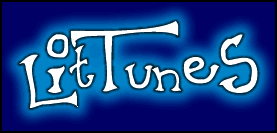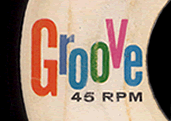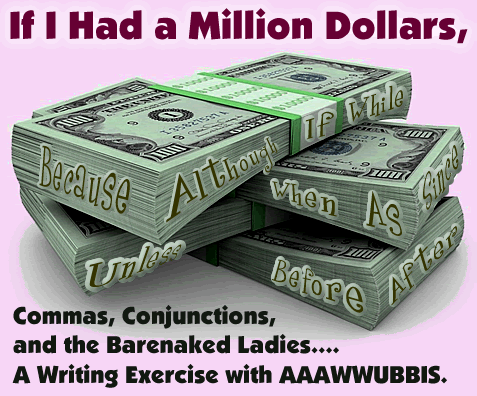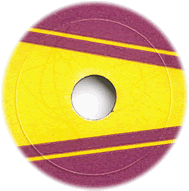|


A Grammar
Lesson with a
Different Twist
Invites Students to
Spend a Million Dollars
as They Learn all about AAAWWUBBIS.
a lesson plan by Cindy Williams
If I had a million dollars, I'd buy you a house
If I had a million dollars, I'd buy you furniture for your house
If I had a million dollars, I'd buy you a K-Car
If I had a million dollars, I'd buy your love
Introduction:
Engaging students in the writer’s craft as both writer and editor is an exciting venture when they are able to connect writing to the music of their world. Students discover that grammar and writing are friendly, imaginative opportunities rather than humdrum, unconnected assignments. The invitation to discover writing through the use of music becomes a stimulating educational experience.
Reluctant writers also find themselves intrigued by the connections between writing and music. In this lesson, I reinforce the use of subordinate conjunctions as “comma causers” by inviting students to notice grammatical structures in the song “If I Had a Million Dollars.” I then invite them to imitate the lyrical structure of the song in their writing, thus experimenting with the use of subordinate clauses and “comma causers.”
Involving students in their own learning encourages them to create more knowledge and leads them to reflect on and talk about how the grammar they identify in lyrics can change their understanding of writing styles and techniques. By relating their understanding of the written word to the lyrics of a pop tune, students are invited to notice patterns and rhythms that set purposefully arranged words to the music they love. They see how good writers purposefully choose their words to serve a creative or dramatic purpose.
As students discover the techniques, patterns, and structures that lyricists use to craft their music, they begin to recognize similarities between lyrics and their writing. They have begun the purposeful journey of “unpacking” the rhetoric of writing by making connections to its usefulness in their world.
 EDITOR’S NOTE: AAAWWUBBIS is an acronym favored by English teachers who understand the value of foundational grammar for effective student writing. The 10 words of the acronym form a list of subordinating conjunctions or prepositions, depending on the word's function in a sentence. In either case, each member of the AAAWWUBBIS class stands at the beginning of the sentence and demands a comma at the end of the clause or phrase. A handout of the list is available for download at the end of the lesson plan.
EDITOR’S NOTE: AAAWWUBBIS is an acronym favored by English teachers who understand the value of foundational grammar for effective student writing. The 10 words of the acronym form a list of subordinating conjunctions or prepositions, depending on the word's function in a sentence. In either case, each member of the AAAWWUBBIS class stands at the beginning of the sentence and demands a comma at the end of the clause or phrase. A handout of the list is available for download at the end of the lesson plan.
Type of activity:
Classroom listening and writing.
Grade level:
Eight through twelve; may be adapted to other levels.
Approximate time:
One class period of 30 to 45 minutes.
Objective:
Students will pursue four objectives.
1. Reinforce AAAWWUBBIS —
subordinate conjunctions as “comma causers.”
2. Connect/develop concepts and learn patterns with an invitational attitude towards writing.
3. Participate by listening to musical selection and discuss how the lyrics use clauses as a form of “comma causers.”
4. Imitate the AAAWWUBBIS pattern by following each dependent clause with a comma.
Materials:
- AAAWWUBBIS list or sign posted in classroom.
- Lyrics to “If I Had a Million Dollars.”
- CD player or iPod with speakers.
- Song: “If I Had a Million Dollars” by Barenaked Ladies.
- Teacher examples as a model.
- Writer’s notebooks or paper and pen.
Procedure:
1. READ
When students walk into class, have lyrics to “If I Had a Million Dollars” by Barenaked Ladies posted on Elmo/overhead.
NOTE: Two sets of lyrics are provided for the teacher. One, titled "Short Version of Lyrics," is edited to provide a quick and easy punctuation reference attuned to the AAAWWUBBIS model. It is altered to emphasize grammatical issues relevant to the lesson. The second set, "Complete Version of Lyrics," includes the entire text of the song. Some lines are combined and punctuated with commas to signal the presence of dependent clauses in the lyrical structure. You'll also find a link to the lyrics at the end of the lesson plan.
2. LISTEN
After students settle, have them look at the lyrics while you play the song.
3. OBSERVE and SHARE
Next, ask students what they notice about the lyrics. Some will notice details in the song, but following more ‘what else?’ students will notice that each idea begins with “If” — one of the AAAWWUBBIS’s from a previous lesson. If students do not “notice” the commas following the dependent clauses, simply ask, “What do you see after those if clauses — every time?” (Anderson, 2007, p 39).
4. WRITE
Following the lyric patterns, have students brainstorm a list of ten or more “If I had a million dollars.” I show them a few of my own:
If I had a million dollars, all of my children would go to college.
If I had a million dollars, I could help my brother.
If I had a million dollars, my front yard would look like the botanical gardens.
Make sure to tell them to write If I had a million dollars COMMA at the beginning of every sentence. Invite them to follow the comma with their own sentence ideas.
5. SHARE and REINFORCE
Each student (or those who volunteer) is encouraged to read a sentence from the brainstorm list. When students read their sentences aloud, they say “comma” aloud, too. Remind them to be sure to use the punctuation mark comma in their writing.
If students hear a phrase they like, invite them to take a moment to add it to their own list.
6. CHOOSE TOPIC
“After we share and add to our lists, students reread their lists and put a star next to two or three they have the most to say about, perhaps combining a few that we see a connection among” (Anderson, 2007, p. 40).
7. WRITE and REINFORCE
Finally, students choose a topic from their list to freewrite. However, before they write, I tell them to structure their freewrites by starting every sentence with an AAAWWUBBIS word, which means they will probably need a comma (Anderson, 2007, p. 40). Each sentence begins with a different AAAWWUBBIS word. For students in grades eight through twelve, the activity should require no less than a five-sentence paragraph.
The AAAWWUBBIS (subordinating conjunctions) list will have been posted somewhere in the classroom for students to refer. Some will use these in their paragraph in AAAWWUBBIS order, some will mix them up — either works well.
8. SHARE
Students share their creation with the class, a group, or a partner.
Summary:
According to Jeff Anderson’s Everyday Editing, this lesson presents “. . . a little chunk of the editing story, a digestible everyday chunk, a part of the editing process that interweaves editing, grammar, and writer’s craft, creating both writers and editors” (2007, p. 5). Students are invited “to notice, to read like writers, to come into the world of editing — a friendly place rather than a punishing place, a creational facility rather than a correctional one. When we develop a place where concepts can be developed and patterns can be learned, kids feel safe, take risks, and feel welcome in every stage of the writing process” (2007, p. 15).
Reference:
Anderson, J. (2007). Everyday Editing. Portland, Maine: Stenhouse Publishers.
C.W.
11 / 18 / 09
Printer Friendly Documents:
PLEASE NOTE: The documents linked here are formatted by Adobe Acrobat, a web standard for cross-platform viewing and printing. If your browser is not Acrobat friendly, please visit this link to download the reader. It's safe and it's free and it works!
http://www.adobe.com/products/reader/
If you just can't make it work, please send us an e-mail requesting copies of the handouts in Microsoft Word.
 HANDOUT:
HANDOUT:
AAAWWUBBBIS List
 HANDOUT:
HANDOUT:
Complete Version of Lyrics,
"If I Had A Million Dollars."
 HANDOUT:
HANDOUT:
Short Version of Lyrics,
"If I Had A Million Dollars."
 LINK:
LINK:
Lyrics, "If I Had A Million Dollars,"
Barenaked Ladies
 FOR THE TEACHER:
FOR THE TEACHER:
Text of this Lesson Plan
A B O U T T H E A U T H O R :
Cindy Williams is a graduate assistant at the University of Arkansas. She is pursuing a PhD in Curriculum and Instruction with emphasis in English Education. Cindy received her Bachelor of Science in Education and Master of Education from University of Arkansas.
She taught secondary English for fourteen years and served as an English composition adjunct and a masters education adjunct instructor for a university in Missouri.
Cindy's hobbies are writing, reading, amateur photography, and Photoshop. She lives with her husband Glenn on a farm in Berryville, Arkansas. Her family includes five sons, two daughters-in-law, three step-daughters, two step sons-in-law, and four grandchildren.
To contact Cindy, please e-mail her at cindymw@uark.edu
LitTunes was launched on November 12, 2007.
We invite you to come back often as LitTunes
grows and develops.

LitTunes is a part of the CornDancer family
of open access, non-commercial developmental websites.
CornDancer has participated in the World Wide Web since the summer of 2000.
Submissions are invited.
Contact webmaster at threadspinner@corndancer.com
|
|





